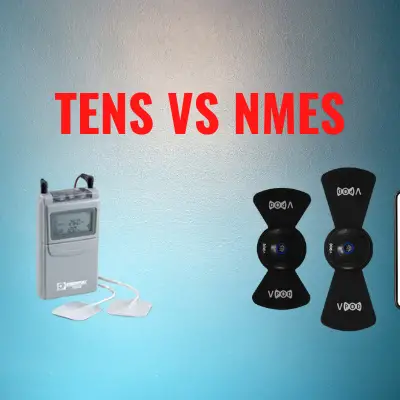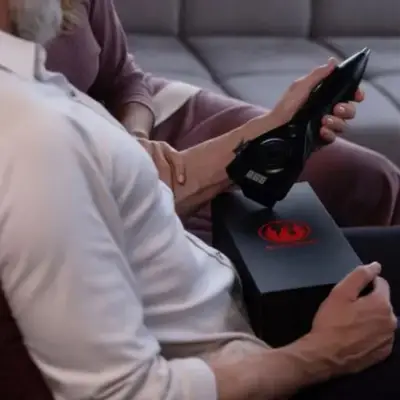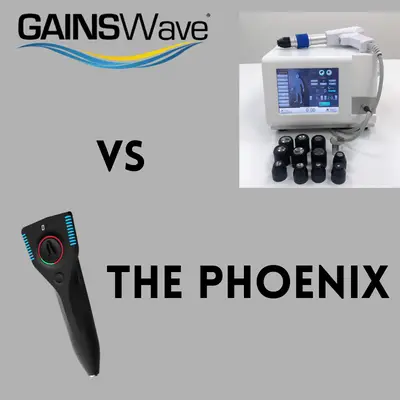TENS and NMES (also known as EMS) are two different physical therapy techniques that are used in pain treatment or to stimulate muscle contractions. Both use an electrical current that targets specific muscle groups and are used in a range of medical and non-medical fields and practices, from sports scientists to physical therapists.
TENS vs NMES- What’s The Difference?
While TENS and NMES units operate on the same principle, they have different purposes and use cases. In both procedures, an electrical current or impulse is sent to specific areas of the body, with TENS primarily used for temporary pain relief, and NMES used for more restorative conditioning or muscle strengthening.
What Is TENS?
Transcutaneous electrical nerve stimulation (TENS) is a non-invasive technique that aims to provide pain relief by passing a light electrical current through specific muscle groups in the body.
TENS units are not curative nor designed for long-term pain relief, and are only intended to provide temporary pain relief to the targeted muscle groups.
TENS devices are usually small, handheld battery-operated units that use sticky electrodes to attach to the skin. These electrodes are attached with wires to the TENS unit and provide a mild electrical current to the desired area.
When the TENS machine is connected and turned on, you will feel a small tingling sensation below the skin. It’s these electrical impulses that help decrease the pain by reducing the electrical signals your nervous system receives from the affected area.
This technique also stimulates the release of endorphins (considered to be the body’s natural defense against pain).
What Conditions Are TENS Devices Used For?
TENS units can help reduce the pain that arises from a number of conditions, including reducing muscle spasms that are often associated with many of these conditions:
• After a surgery
• Arthritis
• Fibromyalgia
• Labor and menstrual pain
• Headaches and migraines
• Sporting injuries
• Nerve pain
• Pelvic pain caused by endometriosis
Want to know how high you can set a TENS unit? Click here to learn more.
Where Is TENS Treatment Available?
TENS treatment is used by a number of medical professionals, including in physical therapy clinics, hospitals, sports psychical therapy clinics, and some hospitals. TENS units are also available for purchase so people can use them at home with the correct training so that the equipment is used properly.
Need to know how to set up a TENS unit? Check it out here.
Does TENS Work?
Scientific evidence is inconclusive at this stage, although preliminary clinical trials do indicate that it is a viable method of pain relief for some patients.
The efficacy of TENS is also dependent on a number of factors, with health professionals stating that current health conditions and the type of injury or illness all play an important factor in how much it can help a patient.
TENS is used particularly in the recovery of an injury, or rehabilitation after surgery, although TENS is very safe to use for a wide variety of pain treatments and is something to be considered before more invasive surgery or taking medication with strong side effects.
What Is NMES?
Neuromuscular Electrical Stimulation or NMES (also known as EMS) sends electrical impulses to nerves or muscle groups and is primarily used as a physical therapy and fitness technique. The electrical stimulation is restorative and often used to re-educate or develop muscle strength after a period of misuse, usually after surgery.
NMES uses a technique called Neuroprosthetics or Functional Electrical Stimulation and refers to the use of electrical stimulation during a task such as walking to re-educate and develop specific muscles required to complete the task.
NMES is also used in the prevention of muscle atrophy due to inactivity or neuromuscular imbalance.
The NMES unit is connected to specific muscle groups and sends repeated electrical impulses that cause the muscles to contract or tighten, offering a similar effect to traditional strength training.
Depending on the treatment required, these electrical impulses can be controlled to be short and frequent, or long and more sustained.
What Conditions Are NMES Devices Used For?
NMES is used in a wide variety of situations where muscle contraction is required. From strength training for athletes, physical rehabilitation after an injury or surgery, to muscle re-education and treatment of muscular dystrophy.
Additionally, NMES can also be used as a therapeutic or cosmetic tool where toning and shaping of particular muscle groups are required.
Where Is NMES Treatment Available?
In the United States, NMES devices are heavily regulated by the U.S. Food and Drug Administration (FDA) with many non-professional devices being banned from sale in the United States.
The FDA divided NMES units into two categories: over the counter devices and prescription devices, with the latter used only under the supervision of an authorized practitioner, and for the following uses:
• Reduction of muscle spasms
• Prevention of disuse atrophy
• Increasing localized blood circulation
• Muscle re-education
• Post-surgical stimulation to prevent venous thrombosis
• Improving a range of motion
For this reason, NMES prescription devices are mainly used by a concentrated group of medical practitioners including sports scientists, professional athlete training centers, psychical therapy clinics, and some hospitals for muscle rehabilitation programs and after orthopedic surgeries.
Non-professional (over-the-counter) NMES devices are only available with FDA certification and many inferior devices are banned or black-listed from sale in the United States due to the potential targeting of home-market consumers being sold NMES devices that could be potentially harmful or hazardous to a person’s health.
Does NMES Work?
After a 2012 study on professionally trained and elite athletes, it was found that the use of NMES had shown the effectiveness of improving strength in a shorter amount of time compared to traditional strength training.
The study also noted another benefit of NMES strength training is that it allows for targeted strength training focusing on specific strength parameters.
NMES is also noted to cause ‘Adaptation of muscle fibers’ allowing for different muscle fibers to be activated with differing degrees of NMES activity.
This varying degree of activity (referred to as programs or protocols) causes a different response from the contraction of different fiber types. Some programs show improvement in fatigue resistance, while others increase strength.
Bottom Line
TENS and NMES are both fantastic options that provide pain relief and muscle recovery. If you are interested in learning more about where to place a TENS electrode pad check out the placement guide here.




